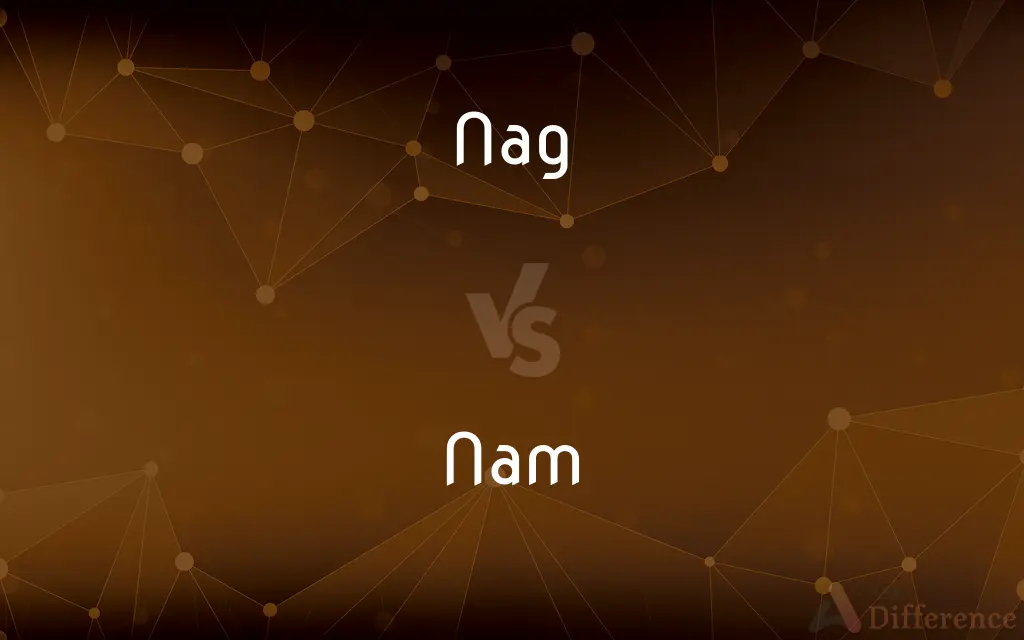NAG vs. NAM — What's the Difference?
Edited by Tayyaba Rehman — By Fiza Rafique — Updated on April 26, 2024
NAG is a monosaccharide involved in the structure of polymers like chitin, while NAM, a derivative of NAG, is specific to bacterial cell walls and is critical in forming peptidoglycan layers.

Difference Between NAG and NAM
Table of Contents
ADVERTISEMENT
Key Differences
NAG, or N-acetylglucosamine, is a component of the polysaccharide chitin, which is found in the exoskeletons of arthropods and cell walls of fungi. NAG plays roles beyond structural, being involved in various biochemical pathways, including the human body where it contributes to joint and gastrointestinal health. On the other hand, NAM, or N-acetylmuramic acid, is closely related to NAG but features a lactic acid group attached, which allows it to form cross-linked peptide chains in bacterial cell walls.
NAG is used widely in dietary supplements due to its role in building cartilage and is also researched for its benefits in multiple biological processes like inflammation reduction and cellular signaling. NAM's significance lies primarily in its structural role in the bacterial cell wall; it provides a backbone for the peptidoglycan that is essential for bacterial integrity and shape.
In terms of molecular structure, while NAG can be seen as a foundational building block, NAM represents a specialized adaptation of NAG where the additional lactic acid group facilitates the formation of complex structures crucial for bacterial survival. This modification makes NAM indispensable in the formation and maintenance of a strong, rigid bacterial cell wall.
Functionally, NAG's versatility allows it to be part of various biological materials and processes, adapting to roles in different organisms ranging from fungi to humans. In contrast, NAM's function is highly specialized; it is synthesized by bacteria and is a target for antibiotics that inhibit the synthesis of the bacterial cell wall, demonstrating its critical role in bacterial physiology.
Both compounds are vital for the organisms in which they occur, their presence and functions highlight a fundamental difference in biological roles NAG as a general structural and functional molecule across various species, and NAM as a specialized component critical to bacterial life, making it a target for antibacterial strategies.
ADVERTISEMENT
Comparison Chart
Structural Role
Part of chitin in exoskeletons
Core component of peptidoglycan
Occurrence
Broad (arthropods, fungi, humans)
Specific to bacteria
Molecular Complexity
Simple monosaccharide
Modified with lactic acid group
Function
Structural, dietary supplements
Structural, target for antibiotics
Biological Impact
Versatile, multi-species use
Bacteria-specific, crucial for survival
Compare with Definitions
Nag
Plays a role in cellular signaling and immune response.
Research indicates NAG's potential in modulating the body's immune system.
Nam
A modified sugar molecule unique to bacteria.
NAM is found exclusively in the peptidoglycan layer of bacterial cell walls.
Nag
Used in medical and cosmetic products for its beneficial properties.
NAG is used in creams for its skin-rejuvenating properties.
Nam
Acts as a linkage point for peptide chains in peptidoglycan.
NAM cross-links provide the structural integrity necessary for bacterial cell walls.
Nag
A monosaccharide that is a building block of chitin.
NAG is crucial in forming the tough outer skeletons of insects.
Nam
Essential for bacterial morphology and survival.
Without NAM, bacteria cannot maintain their shape or resist osmotic pressure.
Nag
Harass (someone) constantly to do something that they are averse to
He's always nagging at her for staying out late
She nagged him to do the housework
She constantly nags her daughter about getting married
Nam
A direct target in the design of specific antibiotics.
Penicillin works by inhibiting enzymes that synthesize NAM in bacteria.
Nag
A person who nags someone to do something.
Nam
Its synthesis and utilization are crucial for bacterial life processes.
The biosynthesis of NAM is a key step in bacterial cell wall assembly.
Nag
A horse, especially one that is old or in poor health
The old nag the lad fetched smelled sweaty
Nam
Am not.
Nag
To annoy by constant scolding, complaining, or urging.
Nag
To torment persistently, as with anxiety or pain.
Nag
To scold, complain, or find fault constantly
Nagging at the children.
Nag
To be a constant source of anxiety or annoyance
The half-remembered quotation nagged at my mind.
Nag
One who nags.
Nag
An old or worn-out horse.
Nag
(Slang) A racehorse.
Nag
(Archaic) A small saddle horse or pony.
Nag
A small horse; a pony.
Nag
An old, useless horse.
Nag
A paramour.
Nag
Someone or something that nags.
Nag
A repeated complaint or reminder.
Nag
A persistent, bothersome thought or worry.
Nag
(ambitransitive) To repeatedly remind or complain to (someone) in an annoying way, often about insignificant or unnecessary matters.
Anyone would think that I nagged at you, Amanda! (From Amanda! by Robin Klein)
Nag
To bother with persistent thoughts or memories.
The notion that he forgot something nagged him the rest of the day.
Nag
To bother or disturb persistently in any way.
A nagging pain in his left knee
A nagging north wind
Nag
A small horse; a pony; hence, any horse, especially one that is of inferior breeding or useless.
Nag
A paramour; - in contempt.
Nag
A person who nags, especially habitually; called also nagger.
Nag
To tease in a petty way; to scold habitually; to annoy; to fret pertinaciously.
Nag
Someone (especially a woman) who annoys people by constantly finding fault
Nag
An old or over-worked horse
Nag
Bother persistently with trivial complaints;
She nags her husband all day long
Nag
Worry persistently;
Nagging concerns and doubts
Nag
Remind or urge constantly;
She nagged to take a vacation
Nag
Involved in various health supplements.
NAG supplements are often taken to support joint and digestive health.
Nag
Common in the biotic environment, from fungi to human tissues.
NAG functions significantly in fungal cell walls and human cartilage.
Common Curiosities
Why is NAM targeted by antibiotics?
NAM plays a critical role in bacterial cell wall synthesis; disrupting NAM synthesis compromises the bacterial cell wall, leading to bacterial death.
What is the main difference between NAG and NAM?
NAG is a general structural monosaccharide found in multiple organisms, while NAM is a specialized bacterial sugar crucial for cell wall integrity.
Can NAG be used in medicine?
Yes, NAG is used in dietary supplements for joint and gastrointestinal health and is being researched for its anti-inflammatory properties.
Where is NAG found in nature?
NAG is part of chitin, found in the exoskeletons of arthropods like insects and crustaceans, as well as in the cell walls of fungi.
How does NAG contribute to human health?
NAG is important for the synthesis of glycosaminoglycans and glycoproteins which are crucial for maintaining healthy cartilage, skin, and mucous membranes.
What role does NAG play in fungal biology?
In fungi, NAG is a key component of chitin, which forms the structural framework of the cell walls, thereby playing a critical role in fungal integrity and growth.
Is NAM found in human cells?
No, NAM is specific to bacteria and is not present in human cells, making it an ideal target for antibacterial drugs without affecting human cells.
Can the inhibition of NAM synthesis be a potential target for new antibiotics?
Yes, targeting the biosynthetic pathways of NAM is a promising approach for developing new antibacterial drugs, especially in combating antibiotic-resistant strains of bacteria.
Are there environmental sources of NAG?
NAG can be derived from natural sources such as the shells of crustaceans and other arthropods, where it is a major component of chitin.
How does NAM assist in bacterial resistance?
NAM forms part of the bacterial cell wall structure that helps bacteria withstand the physical stresses of their environment, contributing to their ability to resist attacks from the host immune system.
Share Your Discovery

Previous Comparison
Toucan vs. Hornbill
Next Comparison
Laden vs. LoadAuthor Spotlight
Written by
Fiza RafiqueFiza Rafique is a skilled content writer at AskDifference.com, where she meticulously refines and enhances written pieces. Drawing from her vast editorial expertise, Fiza ensures clarity, accuracy, and precision in every article. Passionate about language, she continually seeks to elevate the quality of content for readers worldwide.
Edited by
Tayyaba RehmanTayyaba Rehman is a distinguished writer, currently serving as a primary contributor to askdifference.com. As a researcher in semantics and etymology, Tayyaba's passion for the complexity of languages and their distinctions has found a perfect home on the platform. Tayyaba delves into the intricacies of language, distinguishing between commonly confused words and phrases, thereby providing clarity for readers worldwide.














































